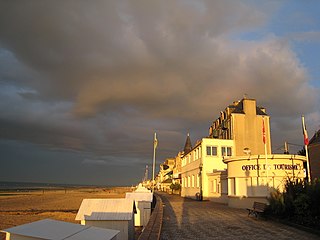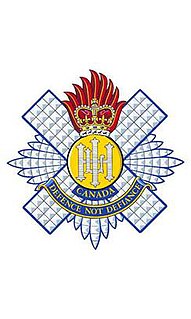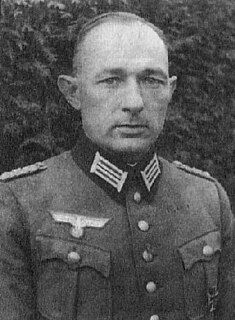Related Research Articles

Juno or Juno Beach was one of five beaches of the Allied invasion of German-occupied France in the Normandy landings on 6 June 1944 during the Second World War. The beach spanned from Courseulles, a village just east of the British beach Gold, to Saint-Aubin-sur-Mer, and just west of the British beach Sword. Taking Juno was the responsibility of the Canadian Army, with sea transport, mine sweeping, and a naval bombardment force provided by the Royal Canadian Navy and the British Royal Navy as well as elements from the Free French, Norwegian, and other Allied navies. The objectives of the 3rd Canadian Infantry Division on D-Day were to cut the Caen-Bayeux road, seize the Carpiquet airport west of Caen, and form a link between the two British beaches on either flank.

The Normandy landings were the landing operations and associated airborne operations on Tuesday, 6 June 1944 of the Allied invasion of Normandy in Operation Overlord during World War II. Codenamed Operation Neptune and often referred to as D-Day, it was the largest seaborne invasion in history. The operation began the liberation of France and laid the foundations of the Allied victory on the Western Front.

Bény-sur-Mer is a commune in the Calvados department (14) in the Normandy region, la Basse-Normandie, in northwestern France, 4.7 km from Bernières-sur-Mer and 5.2 km from Saint-Aubin-sur-Mer. Bény-sur-Mer was liberated on D-Day by Le Régiment de la Chaudière, a French Canadian unit. There was a gun battery located near the town at the time. The locals were surprised to have been liberated by fellow francophones, expecting only English-speaking troops.

Bernières-sur-Mer, in the arrondissement of Caen, is a commune in the Calvados department of Normandy, in northwestern France. Administratively, in the Township of Douvres-la-Délivrande, along its coast the town is 2.1 km to Saint Aubin-sur-Mer, 2.5 km to Courseulles-sur-Mer, and driving south is 4.7 to Beny-sur-Mer.

Graye-sur-Mer is a commune in the Calvados department (14) in the Normandy region, in northwestern France, 1.1 km from Courseulles-sur-Mer, and 3.4 km from Sainte-Croix-sur-Mer.

Saint Aubin-sur-Mer, in the District of Caen, is a commune in the Calvados department (14), of la Basse-Normandie (25), in northwestern France. Administratively, in the Township of Douvres-la-Délivrande, along its coast the town is 2.1 km to Bernieres-sur-Mer, and driving south is 5.1 to Beny-sur-Mer.

The 3rd Canadian Division is a formation of the Canadian Army responsible for the command and mobilization of all army units in the provinces of Manitoba, Saskatchewan, Alberta and British Columbia, as well as all units extending westwards from the city of Thunder Bay.

The Royal Highland Fusiliers of Canada is a Primary Reserve light infantry regiment of the Canadian Army, with companies in Cambridge and Kitchener, and is an infantry sub-unit of 31 Canadian Brigade Group, headquartered in London, Ontario. The Princess Margaret, Countess of Snowdon and The Prince Andrew, Duke of York, as members of the Canadian Royal Family, acted as Colonel-in-Chief

The Juno Beach Centre is a museum located in Courseulles-sur-Mer in the Calvados region of Normandy, France. It is situated immediately behind the beach codenamed Juno, the section of the Allied beachhead on which 14,000 Canadian troops landed on D-Day 6 June 1944.
Clive Michael Law (1954–2017) was a Canadian publisher and author, and founder and President of Service Publications. He wrote and edited several books dealing with the Canadian military, including ground-breaking works on Canadian distinguishing patches worn since 1916, as well as the uniforms of the Canadian Expeditionary Force, and was the Canadian subject matter expert on the Canadian Inglis High-Power Pistol. As a senior public servant for the Government of Canada, he worked with Global Affairs Canada, the Royal Canadian Mounted Police and Transport Canada.

George Kenneth "Ken" Bell was a Canadian photographer who served with the Canadian armed forces during the Second World War. As a Lieutenant in the Canadian Army Film and Photo Unit, he participated in the Normandy Landings, disembarking at Juno Beach on June 6, 1944 with the Highland Light Infantry of Canada. Later he went on to photograph and record the liberation of France, Belgium and the Netherlands, and finally documented the occupation of Germany. After the war he had a successful career as a professional photographer, and published a number of books including Not in Vain, a collection of photographs showing the changes which had taken place in Europe since the end of the war.

Air Marshal George Mitchell Croil CBE, AFC was an American-born Canadian Royal Flying Corps pilot during World War I who went on to become the first Chief of the Air Staff of the Royal Canadian Air Force. Croil resigned as CAS in 1940 and then served as Inspector-General of the RCAF until his retirement in 1944, when the post of Inspector General was abolished.
Jan de Vries, was a Dutch-born Canadian World War II paratrooper and veteran's advocate. His work as a board member of the Juno Beach Centre contributed to its creation.

Garth Webb was a Canadian soldier who founded the Juno Beach Centre. Webb fought in World War II as a member of the 14th Field Regiment, Royal Canadian Artillery. He was awarded the Meritorious Service Cross and the Legion of Honour medal.

Wilhelm Richter (1892–1971) was a German soldier. He was a general in the Wehrmacht during World War II. He is most notable for commanding the 716th Infantry Division during the D-Day Landings in June 1944.
The Reverend Walter Leslie Brown was a Canadian military chaplain who was attached to the Sherbrooke Fusiliers Regiment, 2nd Canadian Armoured Brigade during Operation Overlord. He was murdered by Waffen-SS soldiers after he had surrendered. At the time of his capture he had been wearing the uniform of a Canadian army chaplain.
Ernest Adolphe Côté, was a Canadian soldier, diplomat and civil servant.
George Chow was a Canadian veteran and one of about 600 Chinese Canadians who served in the Second World War.
Francis Godon (1924–2019) was a Canadian Métis soldier.
Charles Warren Bird (1919–2009) was a Canadian veteran.
References
- ↑ Bruce Morton (30 April 2021). "Norman Kirby". The Canadian Encyclopedia.
- ↑ "Norman Kirby". Veterans Affairs Canada. Retrieved 7 June 2021.
- ↑ "'We remember their courage': PM Trudeau's speech from Juno Beach". CTV News. 2:04 and 4:44 min. Retrieved 29 August 2021.